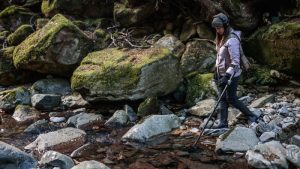A first look at the Cheval Blanc, Seychelles

The Seychelles. You wake up here, in this archipelago set roughly halfway between Madagascar and the Maldives in the Indian Ocean, sit up from the abundance of featherdown and fine Egyptian cotton that swaddles your giant bed, and look out through the floor-to-ceiling glass panel that is your bedroom wall. If you’re clever, you’ll have left the shades up, because Mother Nature, as she is wont to do in equatorial places like this one, has curated a morning horizon that’s as gorgeous as a Rothko, the mineral-blue skin of the sea stitched to the cloudless apricot sky in a straight, bright cobalt seam.
Walk across the sprawling sleeping area of your hillside villa – done almost entirely in variations on intricate white latticing, like the world’s chicest, most sumptuously furnished birdcage – and slide back one of the several glass doors. From the teak deck next to your 12m-long pool, you can admire the dense canopy of poinciana and cinnamon trees, hugging the steep incline all the way down to a ribbon of ivory sand.


The turtle doves are just beginning their call-and-response, the pretty pipe chorus of the jungle. The surf thumps faintly on the sand far below. A lone fruit bat circles lazily in the sky. Behind is your gleaming white eyrie, all smooth surfaces, soft indulgences, cold minibar and controlled climate. In front of you is a 65-million-year-old wilderness: warm, wet, buzzing and clicking.
Cheval Blanc Seychelles is the brand’s first “Maison” in Africa, the newest property in LVMH Hotel Management’s most exclusive portfolio, which opened exactly one week ago. The now six properties that make up the Cheval Blanc portfolio – the name taken from the French château acquired in 1998 by LVMH chairman Bernard Arnault – are never referred to as “hotels” or “resorts”. They are Maisons, and their calling card is excellence in the art de recevoir.
When the Cheval Blanc brand was launched in 2006, expectations were vertiginously high: the luxury-goods conglomerate with arguably the most comprehensive understanding of the desires of the world’s most discerning (or at least its richest) consumers was bringing the sum of its expertise to bear on luxury hotel management. Good wasn’t going to cut it; it was going to have to be, as Monsieur Arnault himself told HTSI in October 2021, “the best”.


And the Cheval Blanc Maisons have been right up there, known for their high-spec interiors, sublime food and conspicuous LVMH brand synergies, from the Guerlain-branded spas to the Celine Cabas totes in the concept boutiques to the wine lists. The brand’s first property, Cheval Blanc Courchevel, opened its doors in 2006, but the real buzz erupted in 2013 when Cheval Blanc Randheli, the first full resort, opened in the Maldives in 2013. It was followed a year later by the takeover of Hôtel Saint-Barth Isle de France, on Flamands Beach.
And so it went, in St Tropez (2019), then a Paris flagship (2021), involving a massively costly and ambitious rehabilitation of La Samaritaine, the historic department store on the Seine. And now here.
The Seychelles is one of travel’s great castaway paradigms – barefoot luxury writ in extravagant cursive, often by extravagant resorts with extravagant price tags (the North Island resort, managed by Marriott’s Luxury Collection, commands over €10,000 per night at Easter). Its beaches are some of the most swooned over in the Indian Ocean; its landscapes overflow with rare and spectacular flora; its world-class fly and ocean fishing are catnip to the gentleman adventurer. It’s the right Africa for a Maison, in short. And while it has been some years since the Seychelles was in the sights of that highest stratum of the globetrotting beau monde, Cheval Blanc is betting on having a halo effect that retrains attention on its raw beauty.


It’s a pretty, 40-minute drive from the airport to Anse Intendance beach, where Cheval Blanc now occupies the site of the former Banyan Tree resort. Anse Intendance is laughably picturesque. It’s public, like all beaches here, but access is sufficiently minimal, and rocky, that punters are relatively few. (It’s also unprotected by reefs, and occasionally gets quite big surf; wonderful for lulling one to sleep, if not so much the place for rookie swimmers.)
The entrance drive winds past an enormous lagoon. At its far end is a tiny, pretty Creole cottage, the only structure preserved from the previous resort; it now houses Mizumi, Cheval Blanc’s Japanese restaurant. The villas – 52 in total – are variously set along the sand’s edge, secreted in sunny pockets in the rainforest, or perched on a ridge overlooking the whole bay. The varied inventory is conceived to please the diverse clientele: Brits, Europeans and Russians plump for beach access, Saudis and Emiratis for privacy. (North Americans, the brand’s largest market, apparently “just want the sun”, says general manager Sebastian Gillard.)

Cheval Blanc Paris was designed by Peter Marino, the long-time LVMH collaborator who (kind of) adapted his strident, high-gloss boutique aesthetic to haute hotel-suite requirements. For the Seychelles, the management tapped Jean-Michel Gathy, who designed Randheli in the Maldives. With more than a dozen Aman, One&Only and Four Seasons resorts across Asia, the Middle East and the Indian Ocean to his name, Gathy was the right man for the job “because he doesn’t go around just doing Jean-Michel”, says CEO of Cheval Blanc, Olivier Lefebvre. “He has the same mandate we do, to respect and integrate the local vernacular, traditions and landscape.” He’s also “crazy good” at contending with tricky topography, which the site presented in abundance.
All the villas are enormous – number 26, where I slept, measures 235sq m high on the ridge – and what feels like acres of wall are replaced with glass. The notable exceptions to all the white, ivory and stone are the unique fabric installations that hang above each bed – the work of Joël Andrianomearisoa, the Malagasy artist who in 2019 was the first to ever represent Madagascar at the Venice Biennale. Dense, rough-edged, they jump out from the walls, as captivating and almost as alive-seeming as the views. “The idea here was to create a response to the nature outside – that landscape, that horizon,” Andrianomearisoa says. “The works are a reflection of it, but dreamier and more emotional.”



Good design is important, but so equally is delivering diversion. And when the guest database comprises Roger Federer, the Prince and Princess of Wales and countless universe masters, tech lords, A-list celebrities and the merely fabulously wealthy in between, that’s no small mandate. Besides the spa, there are padel courts, a surf simulator and a movement pavilion next to a huge gym. Le Carrousel, the indoor-outdoor kids’ club, appears to have amusement-park aspirations.
And then there is the food. Throughout November, LVMH Hotels flew in taskforces from various Cheval Blanc and Belmond properties to critique their way through every experience, and it paid off. There are five restaurants: Le White and Le 1947 are brand regulars, respectively handling casual all-day dining and gastronomy. But the allure of Mizumi – a wide-ranging Japanese menu with continental embellishments, served in the tiny historic house – is fairly irresistible. At Sula, the beach club, a brief, perfect menu of crudi, salads and open-fire grill gives way on Thursday nights to a family-style feast of revisited Creole fare.
Which brings us back to the destination itself – that elemental backdrop onto which Cheval Blanc is projecting its brand of extreme exclusivity. Lefebvre and the team acknowledge that the challenge of building to such rarefied expectations, wherever Cheval Blanc does it, lies in ensuring each property comes alive through connections to the place and the people. This Maison’s design is wonderfully open to the Seychelles’ raw beauty. Here’s hoping the soul of the place will eventually be, too.
Maria Shollenbarger travelled as a guest of Cheval Blanc Seychelles; from $1,680, chevalblanc.com
#Cheval #Blanc #Seychelles








